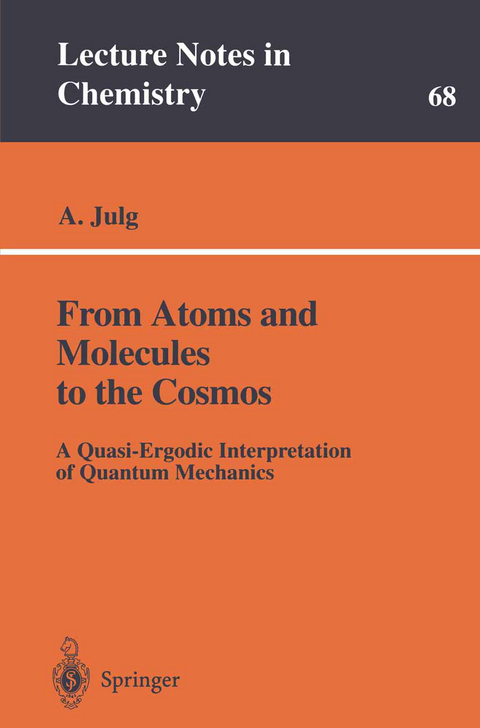
From Atoms and Molecules to the Cosmos
Springer Berlin (Verlag)
978-3-540-64636-5 (ISBN)
I. The quantum formalism and its main interpretations.- The axioms and their immediate consequences. The various interpretations. Practical conclusion.- II. Proposal of a new model.- The apparent failure of the classical physics. Origin of the stability of atoms and molecules. The general properties of the universe field. Direct consequences.- III. A remark about the construction of the operators in quantum mechanics.- The operator associated with the square of the energy. The difficulties to find a general construction rule. Energy fluctuation. Case of the operators associated with Mz2 and M2 . Comparison with experiment. Conclusion.- IV. The problem of enantiomers.- The classical point of view. The quantal point of view. Our interpretation. Analogy with ferromagnetism.- V. Measurement of a property and ergodicity time.- A preliminary remark. Physical meaning of the measurement result. Some arguments for an ergodic interpretation of quantum mechanics. Estimation of the ergodicity time: A quantum approach. Orders of magnitude of the ergodicity time. Other approaches of the ergodicity time. Going back to the measurement axiom.- VI. The molecular structure.- The Born-Oppenheimer approximation. The Woolley paradox. Case of isomers. The chemical bond. The orbitals domains. Case of crystals. Does Quantum Mechanics apply to the universe as a giant molecule?.- VII. A mathematical approach.- The model. Study of the motion. First consequences. Energy balance. The virial theorem. Effect of a virtual deformation of the trajectory. The Hellmann-Feynman theorem. The charged harmonic oscillator. Case of complex particles. The angular momentum. Effect of a magnetic field. Conclusion.- VIII. Connection with the quantum formalism.- Transcription into an operator formalism. TheSchrödinger equation. Coming back to the harmonic oscillator. The rigid rotator in a plane. The time-dependent Schrödinger equation. Origin of the universality of the Schrödinger Equation. Meaning of the quantum formalism. Stabilty of atoms and molecules.- IX. The electron spin.- Ambiguity of the notion. The intrinsic kinetic momentum of the electron. Intrinsic magnetic momentum of electron. Magnetic momentum of positron. The Vaschy theorem. Effect of a constant magnetic field. Correlation in a singlet state. The Bell inequality.- X. The excited states.- The quantal point of view. The excited state in our model. Theorem. Consequences. The Franck-Condon principle. Relationship between the transition energy and the frequency of the radiation. Molecular spectra. Utilizable energy carried by a radiation. Induced emission and laser effect. Connexion with the perturbation theory. Remark about the states of the continuum. Thermalization effect.- XI. Many-particle systems.- Interest of the problem. The Hartree-Fock approximation. Justification of the Hartree-Fock model. Connection between the spin and the Fermi-Dirac statistics. Coming back on the orbital domains. Slater's rules . Hund's rule. Muon-electron systems.- XII. The wave-particle duality.- Origin and interpretation of the concept. The spreading of a wave-packet. Wave associated with a particle. Electron diffraction. The particle in a box. Momentum associated with an electromagnetic radiation - Application to the Compton effect. Closed and unclosed systems.- XIII. Microreversibility and ergodicity.- The specific character of the time variable. Reversibility and irreversibility in Mechanics. Friction, irreversibility and stability. Similarity to our model. Parallelism with entropy.- XIV. Does Planck'sconstant vary versus time?.- The problem of the past variability of the fundamental parameters in physics. A preliminary remark. Experimental data. Choice of a unit system. Derived units. Invariance of the physical laws. Invariance of the light velocity and that of G . First consequences. Connection with the strong and weak interactions. Origin of the time-invariability of a. The principle of conservation of energy. Variation of ? versus the expansion of the universe. Consequences and various applications. Remark about the ? ? 0 limit in quantum mechanics.- Conclusion.
| Erscheint lt. Verlag | 20.10.1998 |
|---|---|
| Reihe/Serie | Lecture Notes in Chemistry |
| Zusatzinfo | XIII, 214 p. |
| Verlagsort | Berlin |
| Sprache | englisch |
| Maße | 155 x 235 mm |
| Gewicht | 1 g |
| Themenwelt | Naturwissenschaften ► Chemie ► Physikalische Chemie |
| Naturwissenschaften ► Physik / Astronomie ► Atom- / Kern- / Molekularphysik | |
| Schlagworte | Atomphysik • HC/Chemie/Theoretische Chemie • Molekularphysik • Quantenmechanik |
| ISBN-10 | 3-540-64636-1 / 3540646361 |
| ISBN-13 | 978-3-540-64636-5 / 9783540646365 |
| Zustand | Neuware |
| Haben Sie eine Frage zum Produkt? |
aus dem Bereich


